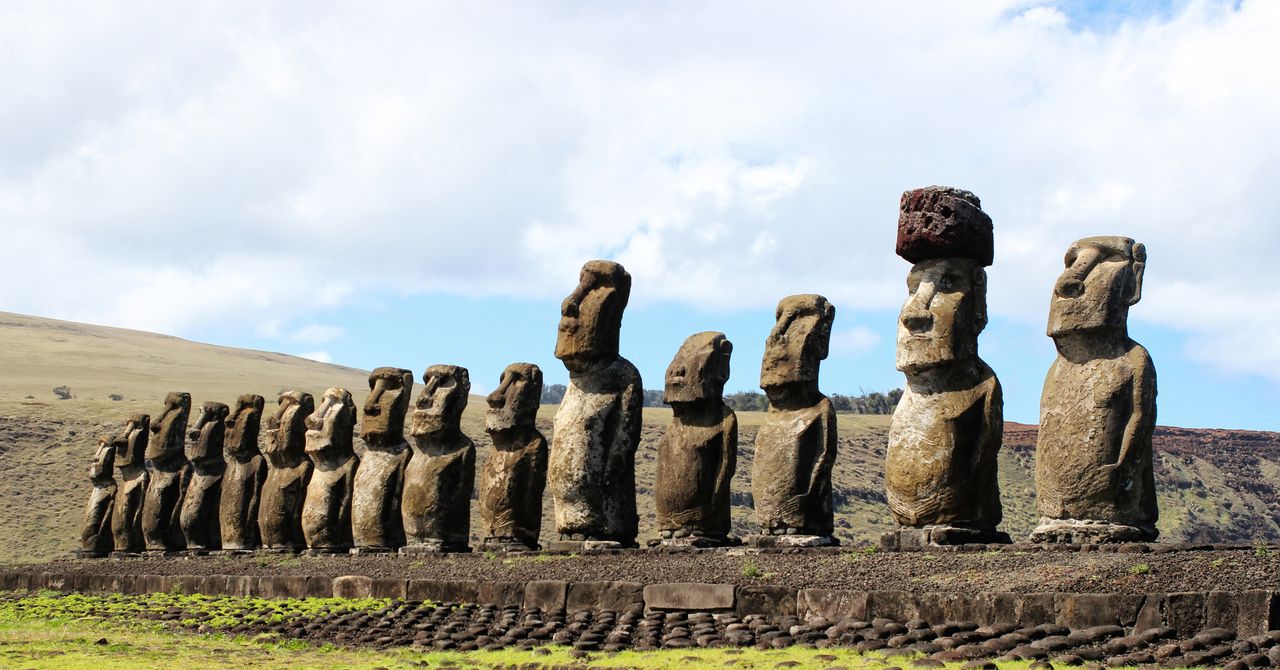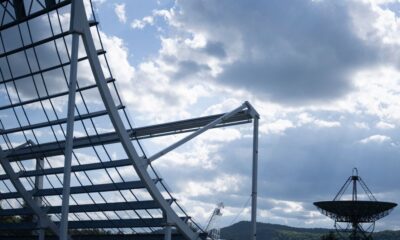Tech
Easter Island’s Moai Statues May Have Walked to Where They Now Stand

Easter Island statues, traditionally known as moai on the remote island of Rapa Nui in the South Pacific, are some of the most impressive artifacts of ancient Polynesian civilization. How the statues were transported has long remained a conundrum, because they can weigh up to several tons yet are scattered throughout the island. Various theories have been proposed, including that they were dragged on wooden sleds or rolled along the ground, but no supportive evidence has backed those claims.
In 2012, a US research team succeeded in propping up a 4.35-ton replica of a moai statue and making it “walk.” The technique, in which two teams using ropes tugged the statue in opposite directions to teeter it forward while a third team ensured it wouldn’t topple over, challenged the conventional theories that moai were moved in a horizontal position.
The question then is how much effort it would have taken to move much larger moai. “Once the moai are in motion, it’s not at all difficult,” explained Carl Lipo, an anthropologist at Binghamton University.
Lipo and his team systematically surveyed 962 moai statues on Easter Island, focusing primarily on 62 found along ancient roads. They recently published a paper providing strong evidence that moai were transported in an upright position.
The team also succeeded in moving an exact replica of roadside moai 100 meters in 40 minutes with only 18 people, a far more efficient result than those of previous experiments.
Researchers demonstrate how the Rapa Nui people may have “walked” moai.
Rules of the Road
The study discovered that moai statues positioned along Rapa Nui’s roads have common characteristics. The broad D-shaped base and forward leaning design of the statues optimized the moai for “walking,” even as they increased in size. In fact, moai abandoned by the side of the road were found to have imbalanced centers of gravity and show signs of toppling over during transport.
This hypothesis is also supported by the ancient roads themselves, which are approximately 4.5 meters wide and have slightly concave cross-sections. Researchers believe these were ideal conditions to aid in stabilizing the moai as they were walked.
A statistical analysis of the distribution of moai showed 51.6 percent were concentrated within 2 km of the quarry where they originated, demonstrating an exponential decay pattern associated with mechanical failure rather than deliberate ceremonial placement. It’s likely these statues were damaged or fell over during transport and left where they lay.
Tech
This AI Model Can Intuit How the Physical World Works

The original version of this story appeared in Quanta Magazine.
Here’s a test for infants: Show them a glass of water on a desk. Hide it behind a wooden board. Now move the board toward the glass. If the board keeps going past the glass, as if it weren’t there, are they surprised? Many 6-month-olds are, and by a year, almost all children have an intuitive notion of an object’s permanence, learned through observation. Now some artificial intelligence models do too.
Researchers have developed an AI system that learns about the world via videos and demonstrates a notion of “surprise” when presented with information that goes against the knowledge it has gleaned.
The model, created by Meta and called Video Joint Embedding Predictive Architecture (V-JEPA), does not make any assumptions about the physics of the world contained in the videos. Nonetheless, it can begin to make sense of how the world works.
“Their claims are, a priori, very plausible, and the results are super interesting,” says Micha Heilbron, a cognitive scientist at the University of Amsterdam who studies how brains and artificial systems make sense of the world.
Higher Abstractions
As the engineers who build self-driving cars know, it can be hard to get an AI system to reliably make sense of what it sees. Most systems designed to “understand” videos in order to either classify their content (“a person playing tennis,” for example) or identify the contours of an object—say, a car up ahead—work in what’s called “pixel space.” The model essentially treats every pixel in a video as equal in importance.
But these pixel-space models come with limitations. Imagine trying to make sense of a suburban street. If the scene has cars, traffic lights and trees, the model might focus too much on irrelevant details such as the motion of the leaves. It might miss the color of the traffic light, or the positions of nearby cars. “When you go to images or video, you don’t want to work in [pixel] space because there are too many details you don’t want to model,” said Randall Balestriero, a computer scientist at Brown University.
Tech
Security News This Week: Oh Crap, Kohler’s Toilet Cameras Aren’t Really End-to-End Encrypted

An AI image creator startup left its database unsecured, exposing more than a million images and videos its users had created—the “overwhelming majority” of which depicted nudes and even nude images of children. A US inspector general report released its official determination that Defense Secretary Pete Hegseth put military personnel at risk through his negligence in the SignalGate scandal, but recommended only a compliance review and consideration of new regulations. Cloudflare’s CEO Matthew Prince told WIRED onstage at our Big Interview event in San Francisco this week that his company has blocked more than 400 billion AI bot requests for its customers since July 1.
A new New York law will require retailers to disclose if personal data collected about you results in algorithmic changes to their prices. And we profiled a new cellular carrier aiming to offer the closest thing possible to truly anonymous phone service—and its founder, Nicholas Merrill, who famously spent a decade-plus in court fighting an FBI surveillance order targeted at one of the customers of his internet service provider.
Putting a camera-enabled digital device in your toilet that uploads an analysis of your actual bodily waste to a corporation represents such a laughably bad idea that, 11 years ago, it was the subject of a parody infomercial. In 2025, it’s an actual product—and one whose privacy problems, despite the marketing copy of the company behind it, have turned out to be exactly as bad as any normal human might have imagined.
Security researcher Simon Fondrie-Teitler this week published a blog post revealing that the Dekota, a camera-packing smart device sold by Kohler, does not in fact use “end-to-end encryption” as it claimed. That term typically means that data is encrypted so that only user devices on either “end” of a conversation can decrypt the information therein, not the server that sits in between them and hosts that encrypted communication. But Fondrie-Teitler found that the Dekota only encrypts its data from the device to the server. In other words, according to the company’s definition of end-to-end encryption, one end is essentially—forgive us—your rear end, and the other is Kohler’s backend, where the images of its output are “decrypted and processed to provide our service,” as the company wrote in a statement to Fondrie-Teitler.
In response to his post pointing out that this is generally not what end-to-end encryption means, Kohler has removed all instances of that term from its descriptions of the Dekota.
The cyberespionage campaign known as Salt Typhoon represents one of the biggest counterintelligence debacles in modern US history. State-sponsored Chinese hackers infiltrated virtually every US telecom and gained access to the real-time calls and texts of Americans—including then presidential and vice-presidential candidates Donald Trump and J.D. Vance. But according to the Financial Times, the US government has declined to impose sanctions on China in response to that hacking spree amid the White House’s effort to reach a trade deal with China’s government. That decision has led to criticism that the administration is backing off key national security initiatives in an effort to accommodate Trump’s economic goals. But it’s worth noting that imposing sanctions in response to espionage has always been a controversial move, given that the United States no doubt carries out plenty of espionage-oriented hacking of its own across the world.
As 2025 draws to a close, the nation’s leading cyberdefense agency, the Cybersecurity and Infrastructure Agency (CISA), still has no director. And the nominee to fill that position, once considered a shoo-in, now faces congressional hurdles that may have permanently tanked his chances to run the agency. Sean Plankey’s name was excluded from a Senate vote Thursday on a panel of appointments, suggesting his nomination may be “over,” according to CyberScoop. Plankey’s nomination had faced various opposition from senators on both sides of the aisle with a broad mix of demands: Florida’s Republican senator Rick Scott had placed a hold on his nomination due to the Department of Homeland Security (DHS) terminating a Coast Guard contract with a company in his state, while North Carolina’s GOP senators opposed any new DHS nominees until disaster relief funding was allocated to their state. Democratic senator Ron Wyden, meanwhile, has demanded CISA publish a long-awaited report on telecom security prior to his appointment, which still has yet to be released.
The Chinese hacking campaign centered around the malware known as “Brickstorm” first came to light in September, when Google warned that the stealthy spy tool has been infecting dozens of victim organizations since 2022. Now CISA, the National Security Agency, and the Canadian Centre for Cybersecurity jointly added to Google’s warnings this week in an advisory about how to spot the malware. They also cautioned that the hackers behind it appear to be positioned not only for espionage targeting US infrastructure but also potentially disruptive cyberattacks, too. Most disturbing, perhaps, is a particular data point from Google, measuring the average time until the Brickstorm breaches have been discovered in a victim’s network: 393 days.
Tech
Top Vimeo Promo Codes and Discounts This Month in 2025

Remember Vimeo? You probably don’t use it to browse videos the way you might with some other services. But if you landed on this page, there’s a good chance you use it to host your professional portfolio. Or assets for your business. Or your short films. Vimeo has tools other video hosting services simply don’t have, like AI editing tools, on-demand content selling, customizable embeds, and collaborative editing features. And best of all: There are no ads. WIRED has rotating Vimeo promo codes to help you save.
Get 10% Off Annual Plans With This Vimeo Promo Code
No matter what you need for your business or career, when it comes to video, Vimeo’s got multiple plans to suit. And luckily, right now, you can save with a Vimeo promo code—even on the annual plans, which already include 40% in savings. Just use Vimeo coupon code GETVIMEO10 to save 10% on your membership plan.
The Easiest Way to Save 40% on Your Vimeo Plan
Vimeo has a few different membership plans that you can save on. No matter which you go with, the easiest way to save a lot is with an annual membership, which has automatic 40% savings compared to paying monthly. And yes, you can even stack promo codes with the annual billing options.
More on Vimeo Pricing and Membership Plans
So what tier do you need? The Starter plan starts at $12 per month (billed annually) or $20 per month (billed monthly). It comes with 100 gigabytes of storage, plus boosted privacy controls, custom video players, custom URLs, and automatic closed captioning.
Boost your plan to Standard for $25 per month (billed annually) or $41 per month (billed monthly) to upgrade to 2 terabytes of storage, 5 “seats” (which are collaborative team member spots), a brand kit, a teleprompter, text-based video editing, AI script generation, and engagement and social analytics.
Finally, there’s the Advanced plan, which costs $75 per month (billed annually) or $125 per month (billed monthly). You’ll get 10 “seats”, 7 terabytes of storage, AI-generated chapters and text summaries, live chat and poll options, plus streaming and live broadcast capabilities.
Use a Vimeo Coupon Code to Get Savings on Vimeo on Demand
Vimeo on Demand is a new way to stream and download movies online. Through Vimeo on Demand, you can rent, buy and subscribe to the best original films, documentaries and series directly from your favorite small business video creators, including The Talent and Wild Magic.
Vimeo Enterprise Solutions 2025
You may have not heard about Vimeo Enterprise, but it’s probably the most essential program for content creators, videographers, and digital media in the workplace in general. From meeting recordings and AI-driven video creation to compliance and distribution, Vimeo Enterprise helps centralize and manage video workflows.
Does Vimeo Have a Free Trial?
While Vimeo doesn’t have a free trial of its paid plans, it does have a free plan with some basic features. Additionally, paid plans can be canceled anytime–within 14 days for an annual subscription, or 3 days for a monthly subscription. You’ll get a full refund if you decide to cancel within the respective timeframes.
-

 Tech7 days ago
Tech7 days agoGet Your Steps In From Your Home Office With This Walking Pad—On Sale This Week
-

 Sports6 days ago
Sports6 days agoIndia Triumphs Over South Africa in First ODI Thanks to Kohli’s Heroics – SUCH TV
-

 Entertainment6 days ago
Entertainment6 days agoSadie Sink talks about the future of Max in ‘Stranger Things’
-

 Fashion6 days ago
Fashion6 days agoResults are in: US Black Friday store visits down, e-visits up, apparel shines
-

 Politics6 days ago
Politics6 days agoElon Musk reveals partner’s half-Indian roots, son’s middle name ‘Sekhar’
-

 Tech6 days ago
Tech6 days agoPrague’s City Center Sparkles, Buzzes, and Burns at the Signal Festival
-

 Sports6 days ago
Sports6 days agoBroncos secure thrilling OT victory over Commanders behind clutch performances
-

 Sports6 days ago
Sports6 days agoF1 set for final-race showdown as Verstappen exploits McLaren blunder | The Express Tribune


















